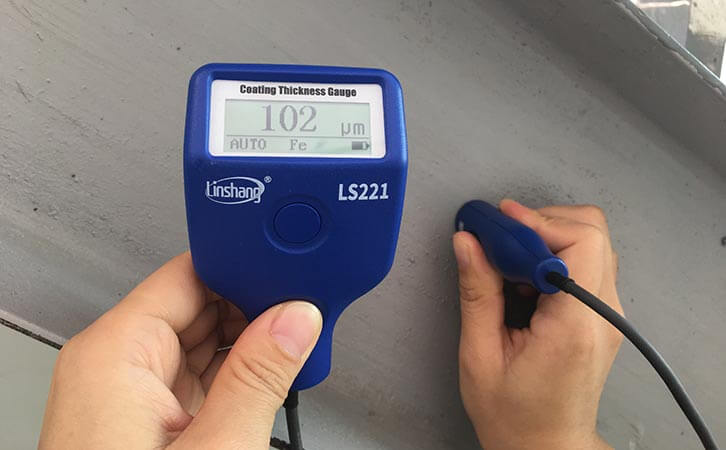Application of Painting Thickness Tester in Steel Structure Industry
With the development of more and more old city renovation projects, more and more steel frame systems are used to replace traditional reinforced concrete. However, we know that steel is easily corroded, so the anticorrosive coating on the surface of these steels is very important. Usually we use a painting thickness tester to check whether the anticorrosive coating on the surface of the steel is up to standard.
1. The preparation of primer
The primer is usually an epoxy zinc-rich primer. Zinc powder is added to the water slurry, deionized water and rheological additives are added to the paint mixing tank. The primer is dispersed into a gelatinous state. The primer was applied to the steel surface. After it was dried, surface coating thickness was measured by a painting thickness tester to be 60 μm.
2. Preparation of intermediate paint
Generally used waterborne epoxy mica as intermediate paint. Intermediate paints generally play a role in preventing corrosion, increasing film thickness and connecting with topcoats. Water-based paints often fail to dry out due to the slow evaporation of water. Therefore, when preparing the intermediate paint, we mainly consider the air permeability after the film is formed. First of all, a stable rheological additive must be selected and a high-shear and low-viscosity rheological additive must be used in the construction process. To meet the film thickness requirements. When this method is used to measure the coating thickness with a painting thickness tester, the coating will have good leveling.
3. The supporting system of the oil coating on the inner surface of the steel box beam
The coating thickness is required on the inner surface of the steel box girder. In the C3 corrosion environment, when the type of the coating is an epoxy zinc-rich primer, the primer is usually required to be brushed once. The paint film thickness after drying is required to be not less than 60 μm measured by a painting thickness tester. The intermediate coating is epoxy varnish. Generally, it needs to be brushed 1-2 times. After each pass of the paint film is dried, use a painting thickness tester to measure its thickness to not less than 100 μm. The topcoat generally uses acrylic aliphatic polyurethane topcoat, which is required to be brushed 2 times. The paint film thickness is not less than 80 μm after each drying measured by a painting thickness tester. After the three layers of paint film have been completely brushed, the thickness of the total dry film is required to be not less than 240 μm.
In the C4 corrosion environment, when the type of the coating is an epoxy zinc-rich primer, the primer is usually required to be brushed once. The paint film thickness after drying is required to be not less than 60 μm measured with a painting thickness tester. The intermediate coating uses epoxy mica paint. Generally, it is required to brush 1-2 times. After each pass, the paint film is dried and the thickness should be not less than 140 μm. The topcoat generally uses acrylic aliphatic polyurethane topcoat, which is required to be brushed 2 times. The paint film thickness is measured to be not less than 80 μm after each drying with a painting thickness tester. After all three layers of paint film have been brushed, the thickness of the total dry film must be no less than 280 μm.
4. LS221 painting thickness tester
It is recommended to use Linshang LS221 painting thickness testerfor measuring the thickness of anticorrosive coating on urban steel frame system. This painting thickness tester uses magnetic thickness measurement and eddy current thickness measurement to measure the thickness of non-magnetic coatings on the magnetic substrate surface. It can also be used to measure the thickness of non-conductive coatings on non-magnetic metal surfaces. The instrument adopts a separate design of the host and the probe, which is very suitable for the narrow space of the steel frame. It is convenient to view the data while measuring in complex environments.
This instrument has the characteristics of fast response speed, high measurement accuracy, stable zero position without drift, and durability. The coating thickness measurement is simple and convenient whether indoors or outdoors.
- High precision coating thickness gauge for used car
- Automotive paint protection films coating thickness gauge
- Plating Thickness Measuring Instrument for Detecting Anti-corrosion Coating
- Linshang LS220, LS191, LS160A– Necessary for Car Cover Inspection
- Coating Thickness Gauge for Second Hand Vehicle
- Zero Adjustment Step of Coating Thickness Gauge
